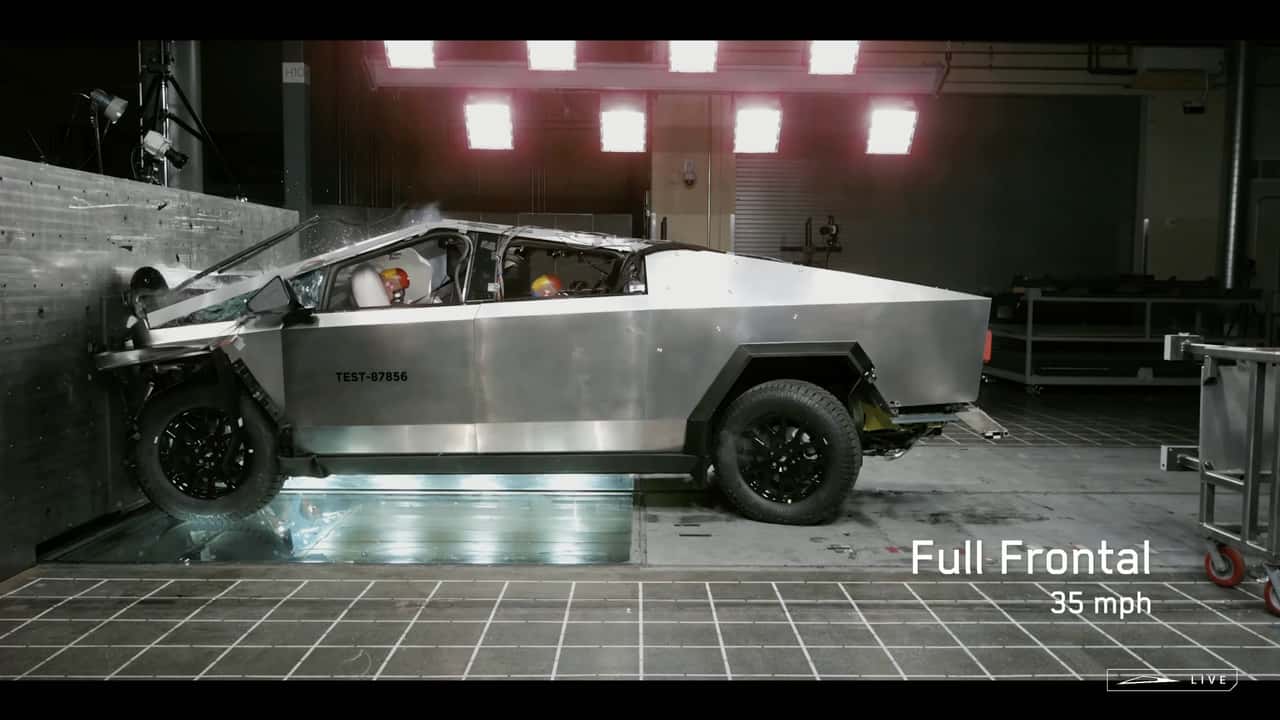Update: Information added from the Cybertruck delivery event on November 30, 2023.
How does an electric truck, claimed to be “nearly impenetrable” by its maker, and built with “ultra hard 30X cold-rolled stainless steel,” fare in a crash test? Footage from last month's delivery event and some previous pictures from a drone flyover together give us some initial clues.
"If you have an argument with another car, you will win," CEO Elon Musk said at the delivery event in Austin, Texas. While some experts have voiced concerns over how it would fare in the real world, Musk recently tweeted that Tesla was "highly confident" that the Cybertruck would be safer than other trucks for both, occupants and pedestrians.
Gallery: Tesla Cybertruck Crash Test
An IIHS spokesperson told InsideEVs that a vehicle's front-end profile did not matter much if the hood height was above 40 inches. And generally, trucks, SUVs, and vans cause more fatalities than cars, as per the IIHS. In the footage released during the delivery event, we saw a full frontal impact test at 35 miles per hour, a side impact test at 38 mph, and a rollover test at 16 mph.
Tesla also said in a tweet on December 12, 2023, that the size of the crumple zone didn't matter. "It's about how you use it [the crumple zone] in a high-speed collision." Tesla added that the Cybertruck’s "front underbody casting was designed to break into small pieces," which "helps reduce occupant impact by absorbing and dispensing energy." It's hard to say if the deformation of the frontal crumple zones is any better or worse than the Ford F-150 Lightning, but here's how the two appear in a side-by-side video comparison.
Previously, drone pilot Joe Tegtmeyer released images of a crash-tested Tesla Cybertruck from a flyover above the Gigafactory Texas. The pictures are unclear, and the aerial rear-three-quarters angle isn’t particularly revealing of what was possibly a frontal offset test. But some details are visible.
The front airbags are deployed, the sharply raked windshield is severely cracked, but not completely shattered, and the doors are knocked off their hinges. The frunk appears to have absorbed the impact and is severely bent—although that’s not necessarily a bad sign as crumple zones in the front and rear are designed to crush and absorb the impact energy.
The drone pilot claims that this was the first verified crash test of the Cybertruck, but it’s certainly not the first time Tesla has tested the structural strength of its EV. In September 2023, images of a Cybertruck that went through a ditch rollover test emerged on social media. The safety results of that test were unclear as well, but the prototype’s roof was bent, airbags deployed, and several exterior parts like fender flares were seen lying in the EV’s bed.
However, the damage seen above isn't indicative of any conclusive results. When the NHTSA and IIHS conduct their comprehensive tests with dummies, and a plethora of sensors, we’ll have a better idea of where the apparently “impenetrable” Cybertruck stands compared to other EVs.
As a reminder, Tesla’s current line-up has earned top safety ratings in American and European crash tests. Most recently, both the 2023 Model Y and Model 3 earned IIHS’ highest Top Safety Pick+ award. The Model X and Model S have also earned 5-star NHTSA ratings in the past. Tesla would likely be gunning for similar results for its electric truck.


